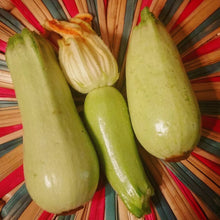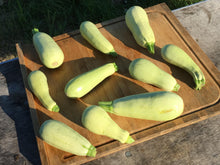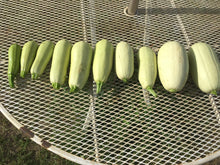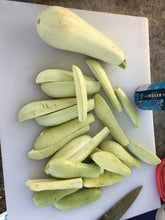'Homs Kousa' Summer Squash
Regular price
$3.75
Sale
Cucurbita Pepo
Origin: Homs, Syria
Improvement status: Landrace
Seeds per packet: ~25
Germination tested 10/2025: 93%
Life cycle: Annual
EFN INTRODUCTION. This productive, drought resistant, vining marrow-type squash produces an abundance of tasty fruit. When they're small and pale green they make a buttery, tender, utterly delicious zucchini. As they grow, they can still be used as a great vegetable for stir-fries, soups, fritters, dumplings, or bread. They can be stuffed and baked, sliced and grilled, or even smoked. There is this "storage marrow" stage in the maturity of this plant that we love, between when it is a young, tender summer squash and a hardened-off tan or yellow fully mature squash. As long as the fruit is still white, it's still good. Picked at this size, it can store on a shelf for 4-8 weeks, maybe more in the right environment. We've eaten them well into the fall after summer harvest. Once it begins to turn tan or yellow, the flesh gets too hard (except perhaps for fermenting) and it's really only good for seeds.
Plants are much more unruly compared to typical bush-type zucchinis, but they are much more productive and more delicious too. At EFN collaborator Clint Freund's farm in Wisconsin in 2018, the Homs Kousa was the last of the various zucchinis that he grew still putting off fruit into the fall. They don't want to give up!
This is one of the best Syrian heirlooms we've identified from the USDA's collection. The people of war-torn Homs who developed this squash have given a great gift to the world in this plant. We've managed to get seeds to Syrian refugees who have a small farm at their camp in Lebanon. We hope to one day be able to rematriate seeds back to farmers in Homs itself during a time of peace.
This seed was grown by Clint Freund and Kass McKinnon of Cultivating the Commons.
GROWING TIPS: Direct seed in May or June, or transplant in healthy plant starts around this time. Plants should end up 30-36 inches apart in rows 5-6 feet apart. They want to sprawl, and keep sprawling.








